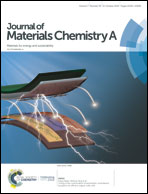Callistemon-like Zn and S codoped CoP nanorod clusters as highly efficient electrocatalysts for neutral-pH overall water splitting†
Abstract
Exploring highly efficient and cost-effective electrocatalysts has become imperative for neutral-pH water splitting, which is environmentally friendly and can reduce the cost of electrolysis systems. Here, we report an effective strategy to design a novel type of callistemon-like Zn and S codoped CoP nanorod clusters by introducing both Zn and S into cobalt phosphide, thereby creating electrocatalysts for highly efficient and stable neutral water splitting. The best Zn and S codoped CoP nanorod clusters on carbon paper (Zn,S–CoP NRCs/CP) require overpotential values of 67 and 391 mV for hydrogen evolution reaction (HER) and oxygen evolution reaction (OER) at 10 mA cm−2 in 1.0 M phosphate-buffered solution, respectively. Remarkably, this enables a neutral electrolyzer to deliver 10 mA cm−2 at a low cell voltage of 1.70 V, which is superior to those afforded by the Pt/C/CP‖IrO2/CP couple and most of the state-of-the-art electrocatalysts. Impressively, this electrolyzer can be powered by an AA battery (∼1.5 V). Density functional theory computations and systematic experiments have verified that the improved HER and OER activities originate from the optimized electronic structures that can facilitate the adsorption and desorption of hydrogen intermediates after introducing Zn and S and accelerating the formation of oxygenated intermediates on CoOOH, respectively. This work provides a new strategy to boost the performance of transition metal phosphides for neutral water or seawater splitting.



 Please wait while we load your content...
Please wait while we load your content...